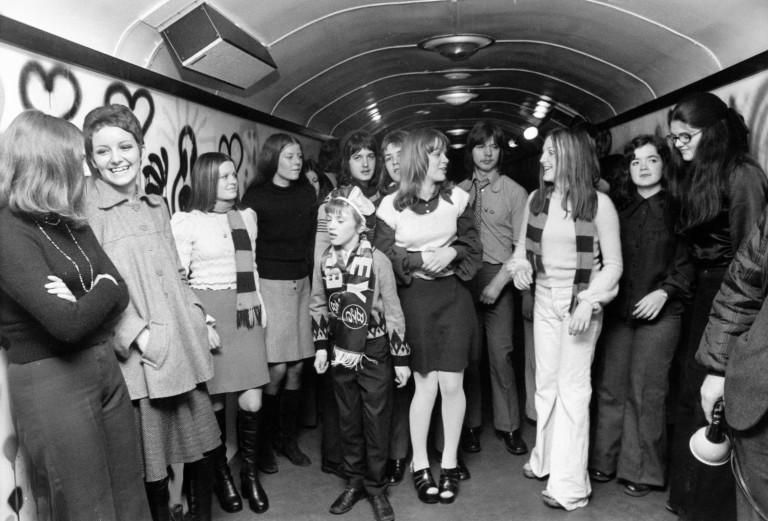 During a time of political turmoil, in which the UK remains despairingly divided on notions of what it means to be British, there remains a unanimous source of national embarrassment: trains.
During a time of political turmoil, in which the UK remains despairingly divided on notions of what it means to be British, there remains a unanimous source of national embarrassment: trains.
No matter who we are or where we’re from, we’re always ready to dive into a blistering diatribe on the dismal state of domestic rail services, lamenting the fact that UK train travel slashes wide holes in our pockets and routinely screws up our timetables. It’s one of the few things we all seem to agree on.
This goes double for football fans, who have had a difficult relationship with the railways for decades. During the sixties and seventies in particular, British trains were routinely dismantled from the inside by bored, frustrated passengers – many of the main culprits being supporters on board the so-called ‘Football Specials’. These direct services were put on to protect the general public as much as giving footy fans an easier route to the game, but they quickly became horseboxes for hooligans.
Tired and weary of the carnage left behind on their carriages every weekend, British Rail wanted to change the atmosphere of football trains, hoping that a ritzy environment would be the remedy for chaos. They decided to trial a luxury service that would stimulate the people on board – aiming to prevent the onset of travel fatigue that spurred supporters to smash stuff up for entertainment. In a more esteemed, high-class party environment, people would want to look the part and behave accordingly.
That was the theory at least, and it paved the way for the Super League Liner – a train packed out with state-of-the-art sound-systems, DJs, dazzling disco lights, windowless walls, and a “cinema room” screening match footage for when passengers needed a timeout from boogying.
The League Liner’s inaugural ride departed from Lancashire in January 1973 and headed to London for Burnley’s game at Queens Park Rangers… and it was pretty much everything that British Rail hoped it would be.
Amongst the Clarets fans were also many other passengers with a passive interest in football at best – people who fancied an afternoon boogie before enjoying a day out in the capital. The promise of a roving party also lured girls to the League Liner’s maiden voyage – young lads knew they were unlikely to impress them by hurling carriage components down the aisles.
The League Liner was earmarked exclusively for the Football League – who would subsequently rent the twelve coaches out to clubs for a designated fixture. Once a team had booked the train, it was theirs for the day. They set the ticket prices and chose the catering options, tailoring every experience to the respective fan base on board (Burnley fans, for example, were treated to Lancashire tripe on their menu).
Several clubs took advantage of the disco train whilst it was in operation – usually for the longer trips that tended to breed tedium. Crystal Palace reserved it for their long trek north to Sunderland, for example, whilst Hartlepool fans clambered inside for their cross-border adventure to South Wales against Swansea. Bolton Wanderers also booked on for their game 250 miles away in Bournemouth.
Occasionally, if they were flying high following a win, the players themselves would hop aboard the League Liner for the journey home – throwing shapes and sipping cans alongside jubilant supporters in multi-coloured saloon cars. The decorum of a football star was a little different back then.

But, whilst the League Liner was a curious experiment, it was ultimately a fruitless one.
Despite the initial excitement and press attention, services proved to be sporadic and short-lived. Fans couldn’t always afford the higher costs (which meant some trains would be left half-empty) and the novelty faded fast – much like the upmarket decor which was ravaged over time and never fully repaired to its plush, original state.
The feel-good vibe didn’t deter rival fans from pelting the exterior whenever the League Liner trundled into destination stations, and when complaints began to roll in about increasing vandalism aboard, British Rail cut their losses, admitted defeat, and pulled the plug in 1976 after just three years of service.
The Liner was quickly consigned to the annals of history, and there’s been no real sign of any kind of modern resurgence since – bar the makeshift coach parties hosted by tanked-up fans slurring along to tinny iPhone music.
The disco train has been largely forgotten, and it’s difficult to foresee a situation where any operators would run a similar service for the football crowd today. Stranger things have happened, of course, but for the time being, any supporters seeking a dose of classic disco with their journey to an away game will have to settle for pumping ‘Kung Fu Fighting’ through their headphones.
GARETH LLOYD
Follow Gareth on Twitter @gazwxm1



One thought on “The Super League Liner – Football’s Forgotten Disco Train”